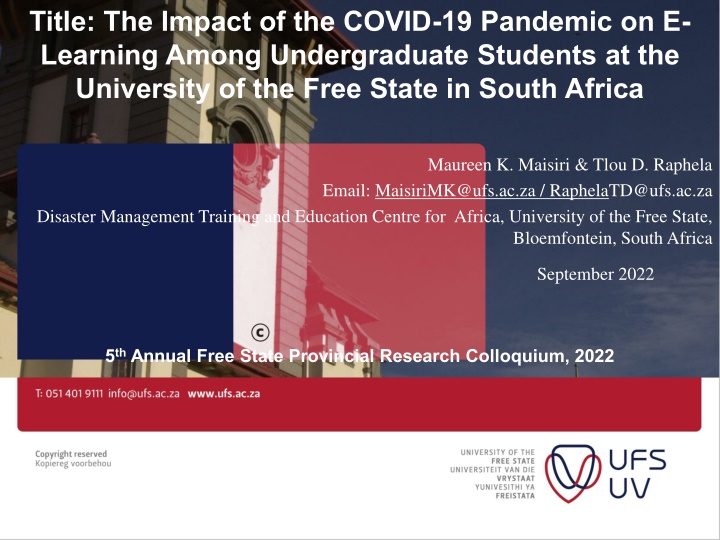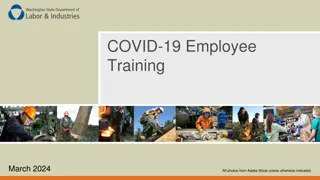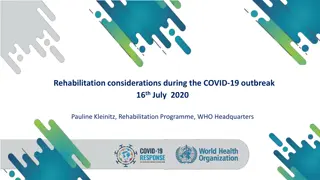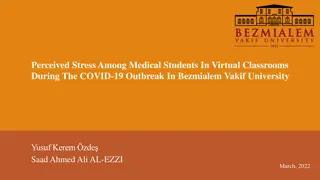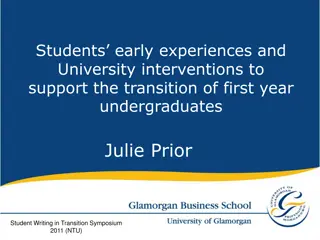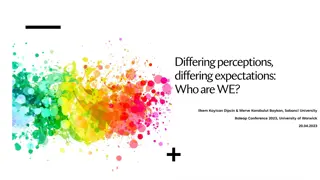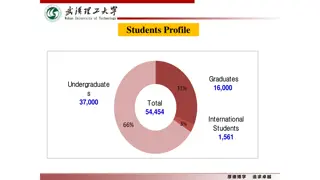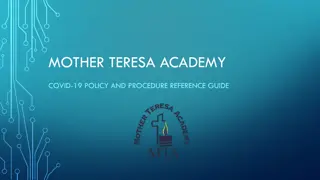Impact of COVID-19 on E-Learning Among Undergraduates at University
The study explores the socio-economic impact of the COVID-19 pandemic on e-learning experiences of undergraduate students at the University of the Free State in South Africa, highlighting challenges and disparities. It aims to address the gaps in understanding students' perceptions and opinions regarding online learning in the context of the pandemic, shedding light on the broader implications for higher education institutions.
Download Presentation

Please find below an Image/Link to download the presentation.
The content on the website is provided AS IS for your information and personal use only. It may not be sold, licensed, or shared on other websites without obtaining consent from the author.If you encounter any issues during the download, it is possible that the publisher has removed the file from their server.
You are allowed to download the files provided on this website for personal or commercial use, subject to the condition that they are used lawfully. All files are the property of their respective owners.
The content on the website is provided AS IS for your information and personal use only. It may not be sold, licensed, or shared on other websites without obtaining consent from the author.
E N D
Presentation Transcript
Title: The Impact of the COVID-19 Pandemic on E- Learning Among Undergraduate Students at the University of the Free State in South Africa Maureen K. Maisiri & Tlou D. Raphela Email: MaisiriMK@ufs.ac.za / RaphelaTD@ufs.ac.za Disaster Management Training and Education Centre for Africa, University of the Free State, Bloemfontein, South Africa September 2022 5thAnnual Free State Provincial Research Colloquium, 2022
Introduction Globally, over 1.2 billion children were out of the classroom in the early days of the pandemic (UNICEF, 2020). The COVID-19 pandemic has led to the closure of schools across the world (Adedoyin and Soykan, 2020). The COVID-19 pandemic has forced many organisations to implement serious technological changes and transformation for business continuity, leading to challenges.
Introduction cont.. Changes have been necessary for the higher education sector. WHY Studies compared web-based tutorials with conventional classroom teaching (Kumari, 2021). These two phenomena differ substantially.
Introduction cont. The impact of communicating within the different settings can have a direct negative effect on students (Al-Rawashdeh, 2021)
Study aim This study gauged how COVID-19 exposes the socio-economic inequalities among undergraduate students at the University of the Fee State (UFS) focusing on e-learning.
Motivation Muthuprasad et al. (2021) highlighted the potential bottlenecks for the success of online learning A literature review did not show any study that documented student s opinions and perception especially in South Africa. This study tries to fill this gap, drawing insights from the literature review to conceptualise the problem, focusing on online learning and its effect on undergraduate students at the UFS.
Problem statement A review study by Adhawi et al. (2020) reported students as the other at-risk group as institutions of higher learning have been closed amidst the pandemic Another study summarised the socio-economic effects of COVID-19 on individual aspects of the world economy (Nicola et al., 2020). Buja et al. (2020) explored demographic and socio-economic factors associated with the rapid spread of COVID-19 in Northern Italy. No one anticipated the far-reaching socio-economic issues exposed by e-learning amongst institutions of higher learning students, in particular, students in developing countries
Methodology Interdisciplinary study. Mixed method Single tool- Data collection Ethical clearance- (UFS-HSD2021/1076 )
Data collection The data collection tool was adopted and amended from Mseleku (2020) Opinion and perceptions of students collected Peak of the 2nd wave of the pandemic in South Africa Online semi-structured questionnaire-data collection
Data collection cont. Google forms survey Opinions from 203 respondents were collected
Data analysis R statistical software (version 4.0.4; 15-02-2021) 1.Descriptive statistics 2. Chi-squared test ( 2 ) P-values significance P 0.05
Results/findings Socio-demographic characteristics of the respondents 203 respondents- 110 females and 93 males Age group 18-25- Majority (n=59) Majority- 4th year students Only responses for gender were not statistically significant
Results/findings Opinions by Gender Figure 1: The number of students that reported the gadgets they are using to attend online classes by gender (A), the number of students that gave reasons for not being able to interact with their peers and lecturers during online classes by gender (B) and the number of students that gave reasons for thinking online classes are not effective by gender (C). ES= Environmental Setup; MNW=Microphone; PC=Poor Connection; TG=Technological Glitches and LPC=Lack of Physical Contact.
Results/findings Opinions by Age Figure 2: Shows the number of students that reported the gadgets they are using to attend online classes by age (A), the number of students that gave reasons for not being able to interact with their peers and lecturers during online classes by age (B) and the number of students that gave reasons for thinking online classes are not effective by age (C). ES=Environmental setup; MNW=Microphone Not Working; PC=Poor Connection; TG=Technological Glitches; LPC=Lack of Physical Contact.
Results/findings Opinions by level of study Figure 3: The number of students according to the gadgets they are using to attend online classes by level of study (A), the number of students that gave reasons for not being able to interact with their peers and lecturers during online classes by level of study (B) and the number of students that gave reasons for thinking online classes are not effective by level of study (C). ES= Environmental Setup; MNW=Microphone; PC=Poor Connection; TG=Technological Glitches and LPC=Lack of Physical Contact
Discussion Opinions by Gender The results of most females using smart phones as compared to their male counterparts to attend online classes exposes the gender imbalances. (Environmental Setup) Studies showed females more glued to their cellphones (Junco et al., 2010; Bratton 2013; Crankshaw et al., 2010) Interestingly, most males, 18-25 years doing their 1st year of study reported lack of physical contact as the reason they thought online classes are not effective (Barab and Duffy, 2000; Kim, 2011, Haper 2007 and Gallo et al., 2020).
Discussion Opinions by Age The 18-25 years age group in most developing African countries share bedrooms with their siblings Libraries and all public spaces were prohibited and closed during the hard lockdown periods. For the above 45 years old age group, the Gen X- this is the generation that was born during the development of the modern computers.
Discussion Opinions by year of study Small screens can have serious health impacts which the 1St years might not be aware of at the moment as opposed to the 4th years. The ability to ask a question, to share an opinion with a fellow student, or to disagree with the point of view in a reading assignment are all fundamental learning activities (Picciano, 2002) In an ideal world I am sure online classes were going to be reported as effective by 1st year students in our study
Conclusion E-learning is a good opportunity- Align with 4IR South Africa is not yet ready -developing
References Barab, S.A. and Duffy, T. (2000.) From practice fields to communities of practice. Theoretical foundations of learning environments, 1(1), 25-55. Bratton, M., 2013. Briefing: Citizens and cell phones in Africa. African Affairs, 112(447), pp.304- 319. Crankshaw, T., Corless, I.B., Giddy, J., Nicholas, P.K., Eichbaum, Q. and Butler, L.M., 2010. Exploring the patterns of use and the feasibility of using cellular phones for clinic appointment reminders and adherence messages in an antiretroviral treatment clinic, Durban, South Africa. AIDS patient care and STDs, 24(11), pp.729-734. Harper, S.R. (2007). Peer support for African American male college achievement: Beyond internalized racism and the burden of acting White . The Journal of Men s Studies, 14(3), 337- 358.
References cont Gallo, L.A., Gallo, T.F., Young, S.L., Moritz, K.M. and Akison, L.K. (2020.) The impact of isolation measures due to COVID-19 on energy intake and physical activity levels in Australian university students. Nutrients, 12(6), p.1865. Junco, R., Merson, D. and Salter, D.W., 2010. The effect of gender, ethnicity, and income on college students' use of communication technologies. Cyberpsychology, Behavior, and Social Networking, 13(6), pp.619-627. Kim, J. (2011.) Developing an instrument to measure social presence in distance higher education. British Journal of Educational Technology, 42(5), 763-777. Picciano, A.G. (2002). Beyond student perceptions: Issues of interaction, presence, and performance in an online course. Journal of Asynchronous learning networks, 6(1), 21-40. Soni, V.D., 2020. Global Impact of E-learning during COVID 19. Available at SSRN 3630073.
Thank you!!! Our greatest gratitude goes to the 203 participants who made this study possible.
